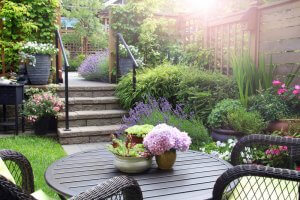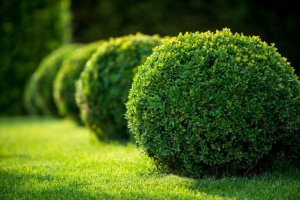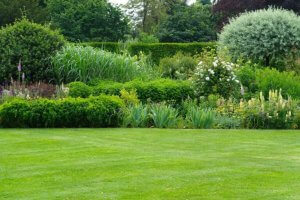How to Choose and Combine Plants for Your Garden

When it comes to designing your ideal garden, knowing how to combine the right plants is the key to success. Getting that perfect mixture of evergreens, flowering plants, climbing plants and shrubs is easier than you might think.
The rich variety of plant species available means you can create a variety of wonderful combinations, and design a garden that suits your individual taste.
So, what are you waiting for? Grab the tape measure, and take a good look at the space you’ve got to work with. We’re going to show you how to get the perfect combinations every time.
How to combine plants for a harmonious garden

One of the best ways to combine plants is to start by arranging them according to their basic type and shape.
Their interesting leaves and colors mean that perennial plants are a fundamental part of any garden arrangement. Because they’re green all year round, you can also use them as dividers between different types of plants, or different sections of your garden.
When it comes to combining your plants, you also need to take the different textures and flower types into account. Similarly, if you decide to incorporate aromatic plants, you’ll also need to think about the different fragrances. This will help you avoid clashing scents, and allow you to personalize your garden.
How to combine plants – getting the right combinations

It’s very important to make sure that no plant blocks out another. Large plants such as trees, conifers, and shrubs can create focal points around the garden, so it’s important to make sure they’re distributed carefully.
Their height means that these larger species should ideally be placed right at the back. All the space in front should be filled with smaller plants and flowers to create a woodland effect.
You’ll also want to incorporate some species of flowering shrubs, such as hydrangeas, and green, flowering climbers such as rose bushes. This is a great way to create really interesting results.
Combining a range of perennial and seasonal plants with a variety of bulbs will help fill your garden with bright, colorful flowers all year round.
And don’t forget creepers! Perfect for carpeting the ground, creepers an ideal substitute for grass, and always look great.
Basic rules for combining plants – shape, texture, and height
Shape

While plants come in many different shapes, we can put them into some basic categories, according to their approximate geometric shape. How you use them will largely depend on where you want the focal points of your garden to be.
Broadly speaking, plants can be divided into the following shapes: pyramid, column, sphere, cone, triangle, fountain (or fan), and horizontal. Understanding these categories and their variations will help you combine them properly, allowing you to create harmony by contrasting their shapes.
Pyramid and column plants are usually fairly tall. These can be used to create interesting focal points. Any onlookers will be forced to look up in order to admire them properly.
Fountain or fan-shaped plants are equally striking. They’re generally slightly smaller than pyramid and column species, so they can be used as a sort of secondary focal point, requiring you to look up only slightly.
When it comes to horizontal species, you don’t need to raise or lower your eyes at all, which allows you to focus on them in a more relaxed way. Spherical plants, on the other hand, will force you to lower your gaze.
Texture

As well as the shape, the leaves and flowers of every species have a different texture. The leaves can be shiny, prickly, fluffy or even velvety, while the flowers can have smooth or fleshy petals.
Using a combination of different textures is the best way to create a really beautiful garden. Arranging them one way will help to highlight a particular section while arranging them another can draw attention away from any problematic areas.
One basic formula for garden design involves planting round, leafy species in the background, placing the largest at the back. The next row should consist of pyramid, cone or triangular plants, which will serve to create a contrast. You can then move on to fan-shaped plants and flowers, before finishing the design with a mixture of creepers.
Height

If you want to combine plants of different heights, it’s important to find out how tall they can grow, and what kind of maintenance they require.
Mixing a variety of trees gives great results. Try combining trees such as maple (measuring 13 to 32 ft) or hawthorn (6.5 to 23 ft) with shrubs like Korean rose (5 to 10 ft) and honeysuckle (1.3 to 2.6 ft).
As you can see, finding the right combination of plants for your garden isn’t all that difficult. We hope you’ve found this post useful, and would love to see the results!
When it comes to designing your ideal garden, knowing how to combine the right plants is the key to success. Getting that perfect mixture of evergreens, flowering plants, climbing plants and shrubs is easier than you might think.
The rich variety of plant species available means you can create a variety of wonderful combinations, and design a garden that suits your individual taste.
So, what are you waiting for? Grab the tape measure, and take a good look at the space you’ve got to work with. We’re going to show you how to get the perfect combinations every time.
How to combine plants for a harmonious garden

One of the best ways to combine plants is to start by arranging them according to their basic type and shape.
Their interesting leaves and colors mean that perennial plants are a fundamental part of any garden arrangement. Because they’re green all year round, you can also use them as dividers between different types of plants, or different sections of your garden.
When it comes to combining your plants, you also need to take the different textures and flower types into account. Similarly, if you decide to incorporate aromatic plants, you’ll also need to think about the different fragrances. This will help you avoid clashing scents, and allow you to personalize your garden.
How to combine plants – getting the right combinations

It’s very important to make sure that no plant blocks out another. Large plants such as trees, conifers, and shrubs can create focal points around the garden, so it’s important to make sure they’re distributed carefully.
Their height means that these larger species should ideally be placed right at the back. All the space in front should be filled with smaller plants and flowers to create a woodland effect.
You’ll also want to incorporate some species of flowering shrubs, such as hydrangeas, and green, flowering climbers such as rose bushes. This is a great way to create really interesting results.
Combining a range of perennial and seasonal plants with a variety of bulbs will help fill your garden with bright, colorful flowers all year round.
And don’t forget creepers! Perfect for carpeting the ground, creepers an ideal substitute for grass, and always look great.
Basic rules for combining plants – shape, texture, and height
Shape

While plants come in many different shapes, we can put them into some basic categories, according to their approximate geometric shape. How you use them will largely depend on where you want the focal points of your garden to be.
Broadly speaking, plants can be divided into the following shapes: pyramid, column, sphere, cone, triangle, fountain (or fan), and horizontal. Understanding these categories and their variations will help you combine them properly, allowing you to create harmony by contrasting their shapes.
Pyramid and column plants are usually fairly tall. These can be used to create interesting focal points. Any onlookers will be forced to look up in order to admire them properly.
Fountain or fan-shaped plants are equally striking. They’re generally slightly smaller than pyramid and column species, so they can be used as a sort of secondary focal point, requiring you to look up only slightly.
When it comes to horizontal species, you don’t need to raise or lower your eyes at all, which allows you to focus on them in a more relaxed way. Spherical plants, on the other hand, will force you to lower your gaze.
Texture

As well as the shape, the leaves and flowers of every species have a different texture. The leaves can be shiny, prickly, fluffy or even velvety, while the flowers can have smooth or fleshy petals.
Using a combination of different textures is the best way to create a really beautiful garden. Arranging them one way will help to highlight a particular section while arranging them another can draw attention away from any problematic areas.
One basic formula for garden design involves planting round, leafy species in the background, placing the largest at the back. The next row should consist of pyramid, cone or triangular plants, which will serve to create a contrast. You can then move on to fan-shaped plants and flowers, before finishing the design with a mixture of creepers.
Height

If you want to combine plants of different heights, it’s important to find out how tall they can grow, and what kind of maintenance they require.
Mixing a variety of trees gives great results. Try combining trees such as maple (measuring 13 to 32 ft) or hawthorn (6.5 to 23 ft) with shrubs like Korean rose (5 to 10 ft) and honeysuckle (1.3 to 2.6 ft).
As you can see, finding the right combination of plants for your garden isn’t all that difficult. We hope you’ve found this post useful, and would love to see the results!







